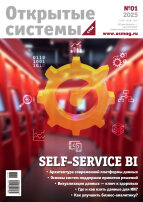.jpg) COVER FEATURES
COVER FEATURES
THE THIRD PLATFORM OF IT
New Hadoop Tools
In the recent years, Hadoop ecosystem has significantly changed morphing into a fully functional scale-out system for data processing that is able to support interactive and streaming workloads. A prominent role in this change was played by Spark, Storm, and Tez projects.
Andrey Nikolayenko (anikolaenko@acm.org), system architect, IBS, Dmitry Volkov (osmag@osp.ru), senior research fellow, Keldysh Institute of Applied Mathematics, editor-in-chief, Open Systems. DBMS
Automated Russian-Language Text Processing
The increased attention to the problem of automated natural language text processing and the resulting emergence of new text analysis methods are among the current key IT industry trends. Yet as of now, there is no unified approach to addressing the issue of generalizing and visualizing large textual data volumes.
Mikhail Dubov (msdubov@gmail.com), graduate student, Boris Mirkin (bmirkin@hse.ru), professor, Higher School of Economics - National Research University (Moscow); Artyom Schal (artiom.shal@gmail.com), expert developer, Polymedia (Moscow)
Distributed Data Processing Problems and Solutions
Initially created for computationally intensive scientific tasks, infrastructures for distributed data processing are beginning to grow popular in other areas. The key problem, however, is choosing software base to build a reliable enough distributed Big Data processing infrastructure at minimal costs.
Sergey Belov (belov@jinr.ru), lead programmer, Igor Pelevanyuk (gavelock@gmail.com), software engineer, Alexander Uzhinskiy (auzhinskiy@jinr.ru), lead programmer, Joint Institute for Nuclear Research (Dubna)
OS PREDICTION
The Advent of «Third Platform»: The OS Big Seven, Ver. 2015
Considering current macroeconomic situation, predictions regarding IT industry development in 2015 promise no radical changes yet clearly pronounce a trend towards technology integration.
Natalya Dubova (osmag@osp.ru), Scientific Editor, Open Systems. DBMS
PLATFORMS
Architecture and Programming Model of Exascale Supercomputer
Computers of exascale performance should be based on a programming model that takes into account all nuances of parallel configurations, whereas the architecture of such a machine must be specifically adapted for threaded program execution.
Viktor Korneev (korv@rdi-kvant.ru), staff worker, Research & Development Institute Kvant (Moscow)
SOFTWARE ENGINEERING
Virtual Teams
Today, working with colleagues in different locations is more common than not, from globally distributed software projects to R&D projects to manifold business processes in companies across all industry sectors. Global software projects, however, have a mixed reputation. To understand what makes some global projects synch and others sink, it’s essential to emphasize that global projects have different flavors.
Darja Smite (darja.smite@bth.se), associate professor, Blekinge Institute of Technology, Marco Kuhrmann (kuhrmann@mmmi.sdu.dk), associate professor, University of Southern Denmark, Patrick Keil (patrick.keil@keil-ktm.com), managing director, Keil KTM
APPLICATIONS
The Semantic Web and End Users: What’s Wrong and How to Fix It
The Semantic Web’s potential to deliver tools that help end users capture, communicate, and manage information has yet to be fulfilled, and far too little research is going into doing so. The author examines the poor state of current tools, argues that the Semantic Web offers a key part of the answer to building better ones, and discusses what needs to change in Semantic Web research to attain that goal.
David R. Karger (karger@mit.edu), professor, Massachusetts Institute of Technology
SECURITY
Browser-to-Browser Security Assurances for WebRTC
For several years, browsers have provided assurance that users are talking to a specific, identified website, protected from network-based attackers. With email, messaging, and other applications for which sites act as intermediaries, additional protections are needed to provide end-to-end security. Here, the authors describe how Web real-Time Communications provide end-to-end security.
Richard L. Barnes (rlb@ipv.sx), security technologist, Martin Thomson (martin.thomson@gmail.com), generalist, Mozilla
STANDARDS
Cybersecurity Standards
A risk-based cybersecurity framework must continuously assimilate new information and track changing stakeholder priorities and adversarial capabilities, using decision-analysis tools to link technical data with expert judgment.
Zachary A. Collier (zachary.a.collier@usace.army.mil), analyst, US Army Engineer Research & Development Center; Daniel DiMase (daniel.dimase@honeywell.com), Standards Committee Chair, Steve Walters, (steve.w.walters@honeywell.com), group chair, Society of Automotive Engineers G-19A Test Laboratory Standards Development Committee; Mark Mohammad Tehranipoor (tehrani@engr.uconn.edu), professor, University of Connecticut; James H. Lambert, professor (lambert@virginia.edu), University of Virginia; Igor Linkov (linkov@usace.army.mil), researcher, US Army Engineer Research & Development Center
VPX Standard: On the Way to Maturity
Initially created as VME computer bus replacement for dual-purpose projects, VPX system architecture now has come of age: today, this is a mature standard allowing to create efficient solutions and enjoying significant market acceptance.
Alexander Kovalev (pr@rtsoft.ru), line director, Viktor Sinenko (rtsoft@rtsoft.ru), industry projects manager, RTSoft (Moscow)
OS MEETING ROOM
Adding Intelligence to Data
With data being a strategic enterprise asset in the digital era, putting it to use is a requirement for today’s businesses. To make the task easier, in the late 2014 Informatica, a provider of data integration tools, has brought out Intelligent Data Platform solution.
Natalya Dubova (osmag@osp.ru), Scientific Editor, Open Systems. DBMS
OS ACADEMY. Workshop
Optimizing SQL Queries Using Rough Sets
Today’s data science and business often live apart: IT companies are mired in «burning» projects and do not have enough resources to try out new methods of data analysis. Meanwhile, these new fresh-developed methods are often too crude to be put on stream. Here we present an analytic data processing technology that is based on rough set theory approximations and is shown to be well suited for Big Data analysis.
Dominik Slezak (slezak@mimuw.edu.pl), professor, University of Warsaw, Yury Kashnitsky (ykashnitsky@hse.ru), intern researcher, Sergey Kuznetsov (skuznetsov@hse.ru), laboratory head, Higher School of Economics - National Research University (Moscow)
OS ACADEMY. Library
Computing in Astronomy
The September issue of Computer Magazine (IEEE Computer Society, Vol. 47, No. 9, 2014) covers the topic of compiting in astronomy.
Sergey D. Kuznetsov (kuzloc@ispras.ru), Professor, Moscow State University
